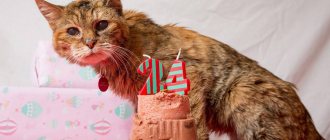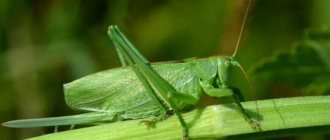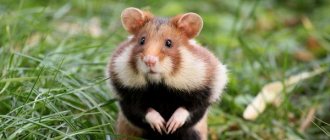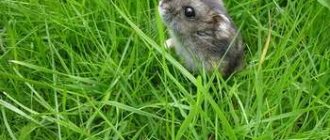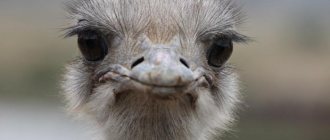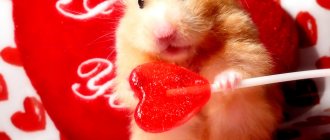Albino hamsters are amazing rodents with white fur and red eyes. Unusual animals serve as easy prey for predators and are extremely rare in the natural environment. And since the unusual appearance of the animals immediately becomes the object of everyone’s attention, they are often kept as pets. Let's figure out what an albino hamster is and how to take care of it.
Keeping the animal
To keep Syrian Royal rodents at home, you need:
- drinking bowl;
- wooden house;
- ladder;
- wheel.
Select all accessories according to the size of the cage and the age and size of your rodent.
Cell
Royal hamsters can be placed in plastic containers. The main requirement is natural ventilation. These are small holes along the entire length of the cell.
The bedding is made from wood sawdust. For toilet procedures, place a special filler in the form of granules in the corner of the cage. It neutralizes unpleasant odors and absorbs excess moisture.
Drinking bowl
The design consists of a tube with a ball inside and a container with water. Plastic is suitable as a material. Secure the accessory between the rods. Adjust the height according to the height of your pet. Usually it is 5-7 cm above the floor.
Royal Syrian hamsters drink little water. The optimal drinking bowl volume is 50 ml. Change the water every 3-4 days.
Wheel
Used for physical activity of Royal Syrian hamsters. Wheel requirement:
- solid plastic;
- presence of serifs;
- diameter 18-20 cm;
- fastening between the rods;
- light weight, etc.
The royal hamster burns off excess weight on the wheel. Sensing danger, he climbs inside and begins to actively run. Can use the device instead of a house and sleep in it.
An alternative is a walking ball. Place the rodent in it for 30 minutes. Increasing free space has a positive effect on the hamster's well-being.
House
Hamsters love houses.
A wooden house is needed for a pet to live. Such animals love solitude and are considered secretive, and therefore their own home gives them the illusion of security and adds comfort. Inside the house, hamsters store their food supplies, rest, sleep, and go to the toilet.
Wood and plastic are excellent materials for a house. The main requirement is the absence of glue and coloring agents on the surface. Hamsters chew on everything in the cage. Licking paint or glue increases the likelihood of diarrhea or intoxication of the body.
Care and maintenance
The animal will rest all day. There is no need to wake him up. At about 18:00 or later, he will wake up and develop vigorous activity. During this period, you can “make acquaintance with him.”
Hamsters are tamed using “sweets.” For the animal, these are not candies and chocolate, which can poison him, but raisins, nuts, and dried fruits.
Gradually he will get used to the hands of the owner, he can be pulled out of the cage and picked up.
It’s funny to watch how a baby takes a cracker with his tiny “hands” and gnaws on it. He spends a lot of time on the wheel, running up to 10 km per night.
The royal hamster is very smart. Will be happy to explore unfamiliar terrain. You should not let him out in a room where he could hide in a hard-to-reach place and get hurt, or be accidentally crushed. You cannot leave it on elevated surfaces: tables, chairs, sofas. The Syrian hamster does not understand heights and will boldly step into the void.
The main component of care is cleaning the cage. The hamster is placed in an additional cage (you can use a pan or a hard cardboard box), and only then the drinker and feeder are removed and the bedding is changed.
Sometimes the rodent leaves reserves in the litter. Pieces of fruits and vegetables spoil. They need to be thrown away, but be sure to be replaced with others. Otherwise, the hamster will panic when he does not find his supplies in place.
He should always have dry food in one of the feeders, otherwise he will constantly make “stocks for the winter.” There should be water in the drinking bowl, which is changed every other day.
The cage should contain branches of fruit trees and mineral stone, which the animal needs to grind down its teeth.
Do hamsters bite?
This question interests most breeders, since the animal is often purchased for a child. Any hamster can bite, regardless of whether it is white or not.
Campbell's hamsters are considered the most aggressive, so you need to wear special gloves when playing and handling them. Syrians have a friendly disposition. They do not show aggression, are willing to be held, and love to play with children.
Djungarian hamsters show aggression towards their relatives and can even bite humans. This is due to the manifestation of dissatisfaction, defense of territory, or the painful condition of the pet. Even the calmest pet can bite a person.
Albinism is a mutation caused by the lack of melanin pigment in the skin, fur and iris of the eyes. Hamsters of any breed can be albinos. For quality care of white rodents, it is necessary to take into account the characteristics of their body.
Taylor
The smallest representatives of the hamster tribe living in America. Their belly is light gray, but their back is dark, gray-brown. There are even black hamsters. The size is not large - there are almost no specimens longer than 8 centimeters.
It lives in the southern states of the United States, as well as in Mexico, Nicaragua and other Central American countries.
It's nice that Taylor's hamsters almost never bite. They can sit on their hands for a long time, caress, and rub against their owner’s fingers. Aggression is usually provoked - for example, if a child accidentally squeezes a rodent too tightly.
Different eye color
The possible relationship of the breed with the Taimyr wolf gives the dog’s gaze a special coldness and mystery, especially if the eyes are blue. But, in addition to the light, sky blue or gray color of the eye iris, the Siberian Husky has black and brown. It is found very often, has a rich, deep tone and goes well with different nose colors (they are not only black, but also beige, flesh-colored with pink streaks) or the color of the dog’s coat: red, beige and white. Representatives of other variants of the breed, not Siberian, have eyes that are reddish and light brown, and also with an olive tint.
Diseases
The black rodent, like the white one, is very vulnerable to disease. They are vulnerable to diseases. Stress, hypothermia, poor nutrition and maintenance can lead to weakened immunity of a dwarf pet. As a result, he gets sick.
Signs of the disease:
- begins to sneeze, sniffle;
- refuses food and drink;
- suddenly loses weight;
- eyes fester and water;
- Aggression and increased drowsiness appear.
If you notice these signs in an animal, you should urgently show it to a veterinarian. Remember, self-treatment of a fluffy can aggravate the situation and lead to irreversible consequences.
Breed Features
Husky, despite its cuteness, is not a beautiful plush toy, but a serious large dog that needs to be provided with decent living conditions. Among the advantages of the breed:
- Friendly, non-aggressive.
- Endurance, good “Siberian” health.
- Accommodating - friendly with small children and pets.
- No odor from skin or animal fur.
- Obedience: the animal almost does not bark.
- Stubborn, wayward animal: needs proper education and training.
- The fluffy husky sheds a lot.
- The dog tends to dominate in the “pack”.
- A sled dog requires daily exercise. Without them, the animal falls into apathy or becomes capricious and nervous.
- Husky is not a watchdog. He is equally friendly with his own people and with strangers.
The dog is unpretentious in grooming: you only need to comb the coat during the molting period and bathe as necessary. The husky takes care of the cleanliness of its coat on its own. The dog sheds twice a year for about 3 weeks: the undercoat changes from summer to winter and vice versa. To prevent the dog from experiencing discomfort, the owner trims its nails.
The mount is undemanding when it comes to food: it equally loves both natural food and dry food. Both should be balanced, high-quality nutrition. Huskies are not prone to obesity, but the owner must monitor the animal's portion and feeding schedule.
The cost of puppies for home breeding is from 20 thousand rubles. Such a dog either does not have a pedigree or is unsuitable for breeding. The price of animals for mating is from 30 thousand rubles. These puppies must have a passport with a list of ancestors. The most expensive huskies are show class, for an exhibition career. Their cost starts from 50 thousand rubles.
The age of babies for sale is 4-6 weeks. A good option is to buy an adult animal. This is no longer a “pig in a poke”, but a dog with an established character, whose behavioral characteristics are immediately visible.
Where did albino rats come from?
In fact, the albino rat is no different from its relative, the gray rat, except for its white fur and often red eyes. Albino white rats were bred in laboratories through scientific research and experiments at the beginning of the last century. It was then that the already well-known decorative rats were bred from these albino rats. Decorative rats were bred by crossing gray rats with albino rats.
The white color of the coat in such animals occurs due to a lack of melanin in the blood. Albino white rats have several types of coats:
- Long wool.
- Wavy coat.
- With a tuft.
Essentially, albino rats have two types of eyes: Regular, like those of ordinary gray rats, and Red. Most people still don't understand and ask the question: "Why do some white rats have red eyes?" Because of this, they begin to dislike such rodents. But it’s true that rodents with such eyes look a little scary. The red color of the eyes is explained by the fact that some rats have albino eyes and lack pigmentation. In more detail, the entire eye is essentially transparent, and all the blood vessels in the eyes of a rodent are visible from the outside, which is why they are red.
The look of an albino rat can sometimes be scary
Today, laboratories continue various studies on white rodents. Because they have the same sets of chromosomes as humans. They are otherwise used to conduct various experiments in the field of:
- Genetics;
- Toxicology;
- Radiobiology;
- Virology;
- Microbiology;
In ordinary gray rats, the appearance of albino offspring is a very rare case. Since such genes are recessive in nature and otherwise disappear under the pressure of the dominant genes of black or gray rats.
Important! Due to the uniqueness and spontaneity of the formation of the set of chromosomes responsible for the white coat color, it is extremely difficult to breed an albino rat at home. White rats are widely used in laboratories
Campbell
Like the previous species, it belongs to the family of dwarf rodents. An inexperienced rodent lover can easily confuse them with the Djungarians, but the Campbell's are distinctive in character and appearance.
Campbell cats are characterized by small ears and no fur on their soles. Regarding behavior, hamsters of this species are difficult to train. In addition, they love to bite. When keeping several individuals, it is highly not recommended to leave them in a cage together: this can cause damage or even death.
Keeping rodents of this species requires a spacious terrarium: they are extremely active, so they will need a lot of space to run.
lovelyhamster.ru
Do hamsters bite?
This question interests most breeders, since the animal is often purchased for a child. Any hamster can bite, regardless of whether it is white or not.
Campbell's hamsters are considered the most aggressive, so you need to wear special gloves when playing and handling them. Syrians have a friendly disposition. They do not show aggression, are willing to be held, and love to play with children.
Djungarian hamsters show aggression towards their relatives and can even bite humans. This is due to the manifestation of dissatisfaction, defense of territory, or the painful condition of the pet. Even the calmest pet can bite a person.
Albinism is a mutation caused by the lack of melanin pigment in the skin, fur and iris of the eyes. Hamsters of any breed can be albinos. For quality care of white rodents, it is necessary to take into account the characteristics of their body.
Hamsters are very special pets. There are more than 20 breeds of hamsters, but no more than 5 main species are kept as pets. Below is a list of the most common types of hamsters with photographs.
What to fear?
It happens that an ordinary non-albino hamster, with black eyes and not white fur, suddenly develops redness in or around the eyes, which has never been observed before. Here you cannot do without consultation and a thorough examination of the baby by a veterinarian.
Most likely, treatment will be needed, since hamsters, like other representatives of the fauna, are often susceptible to diseases. In a number of ailments, the eye may be directly affected, or redness will only be a symptom of a disease in another organ. The vigilance of the owner and a thorough examination of the animal by a specialist are the most important factors for timely and effective treatment.
Choosing and arranging a home
In order for animals to live comfortably, it is important to take care of the improvement of their home.
Size and material
Albino hamsters are loners and prefer privacy. It is recommended that each individual purchase a separate spacious cage - if you put 2 hamsters in one cage, they can show aggression towards each other.
You should not skimp on the size of a house for a rodent - the larger it is, the more comfortable it will be for the pet; the required minimum is 30x50 cm. The bars of the cage should be made of metal, since animals can chew through plastic.
Did you know?
Hamsters are not able to distinguish colors - they are color blind.
What does a hamster need in a cage?
In order for an albino to feel cozy and comfortable in his home, it should be properly equipped:
- litter
You can scatter sawdust at the bottom of the cage - it will be comfortable and soft for the hamster to move around; - house for sleeping
. You should definitely place a small house in the cage where the animal can rest and hide from the light during the day; - feeder and drinking bowl.
Place a feeder and water bowl in the cage. It is advisable that they be made from materials that the pet cannot chew; - toilet.
To prevent your pet from shitting all over the cage, you need to place a special toilet in it, which can be purchased at a pet store; - mineral stone.
From time to time, rodents need to wear down their teeth by gnawing on something hard. Mineral stone is ideal for this - they are commercially available in abundance and come in different forms and compositions (with the addition of vitamins, minerals, herbs, etc.); - running wheel and swing.
Hamsters are quite active animals, so to prevent your pet from getting bored, you should take care of his leisure time and place some entertainment in the cage;
Unfortunately, if you don't properly care for your rodent, it can get sick, so it's worth familiarizing yourself with some important tips.
Grooming
To ensure that the animal’s snow-white coat always remains fluffy and beautiful, you need to purchase special sand at the pet store and use it to make baths for your pet. Bathing animals is prohibited. In addition, it is not recommended to keep albinos with individuals with normal pigmentation.
Care for claws and teeth
Hamsters' teeth grow quite quickly, so they should be given solid food so that the animals can grind their teeth down on it.
If this is not done, then the presence of long and sharp teeth will create discomfort while eating.
Particular attention should be paid to the claws. To cut them, use special manicure scissors.
A nail file is not suitable for this procedure, as the animal may become frightened and accidentally injure itself. If you suddenly injure your pet, you need to wrap the paw with a bandage and wash the cage so that infection does not enter the wound.
Important! Albinos' claws, like the animals themselves, are light-colored, so they need to be cut in good light - during the day or under a lamp, so as not to injure the animal.
Cleaning the cage
It is important to keep the cage clean. Litter should be changed at least twice a week
The water in the drinking bowl should always be fresh, so it is worth changing it every day, or better yet, in the morning, afternoon and evening. The use of synthetic detergents for washing drinkers and bowls is strictly prohibited: for these purposes, use tooth powder or baking soda. The toilet needs to be cleaned every day.
While the cage is being cleaned, the hamster can be placed in a jar, into which sawdust should be poured in advance.
Breed Features
Red eyes are considered normal only in hamsters of a certain coat color - white. They are similar in appearance to each other, but differ greatly from the usual pigmentation of the coat. The color is uniform, it does not have dark inclusions or other shades. Its snow-whiteness only emphasizes the redness of the eyeballs.
Below we will answer two of the most popular questions regarding the health of a small pet.
https://youtube.com/watch?v=EB_qaEClMWw
Why do albino hamsters have red eyes?
Sometimes it turns out that the most common rodent parents (in particular, Syrian hamsters) give birth to offspring whose fur has no pigmentation at all. The idea that albinos are a separate breed is erroneous. Such cubs are born among any breed. This is due to some genetic mutations, which in turn do not affect the behavior or health of hamsters.
Albino fluffies are considered very valuable representatives of the family, because it is almost impossible to breed them artificially. The uncharacteristic color is the result of the fact that the body of these rodents does not produce melanin, which is responsible for pigmentation. Because of this, blood vessels and capillaries are visible through the transparent membrane of the eyes.
It is quite difficult to meet albinos in the wild, because they fall prey to predators (their white color gives them away), but at home such a pet can live for about four years.
White hamsters with red eyes are slightly different from their relatives in size and character. The Djungarian albino hamster can be quite aggressive towards other representatives of the breed, while the Syrian is larger in size, but it easily gets used to hands and is unpretentious.
Why do hamsters have yellow teeth?
This question also worries the owners of these cute fluffies. This is not a disease, but a norm. Since rodents' teeth grow constantly, the animals have to grind them down on their own. Because of this, the protective layer of enamel on the incisors increases, making them stronger. The yellower the teeth, the stronger they are.
Rodents' teeth are not brushed, but every six months he needs to be taken to a dentist for a dental examination.
Appearance
Hamsters of this species are very small, they are called dwarf for a reason. They grow from 7 to 10 cm in length. In the wild, their weight reaches 20 g, in domestic conditions they can weigh up to 45 g.
A very cute creature - the Siberian hamster. The photo of the animal conveys its beauty and grace. The summer color of the rodent is gray, there is a black longitudinal stripe along the length of the back, the tail and ears are dark gray. The paws are short and covered with fur down to the soles. The belly is light gray in color. Shiny charcoal eyes, small nose. The fur is soft and smooth.
By winter, the animal begins to molt. The dark spots on the fur disappear, and the hamster becomes almost white, and the black stripe on the back becomes dark gray. Shedding depends on the length of daylight hours and can last up to 5 weeks.
It is worth noting that seasonal molting may not occur in domesticated Siberians.
What to feed white hamsters?
Foods high in carotenoids are beneficial for the health of hamsters. The rodent's diet should be balanced, varied and include the following products:
- Fresh vegetables. Carrots, beets, zucchini and pumpkin are suitable for hamsters.
- Fruits. Apples and pears contain substances necessary for the health of jungarians. Gnawing hard fruits, the animals wear down their incisors.
- Fresh greens. Dill, parsley, lettuce, clover and spinach can be given individually or made into a luscious herbal mixture.
- Nuts. Hazelnuts and peanuts are beneficial for rodents; almonds are hazardous to health.
- Specialized feed. You can find them at a pet store, or you can prepare them yourself. To do this, mix buckwheat, lentils, wheat, corn and rolled oats.
- Protein food. Chicken meat, shrimp, boiled eggs, as well as small insects should be present in the animal’s diet.
Albinos should not be fed fatty or fried foods. Spicy and salty foods are contraindicated for them. Feed the animal at least twice a day, pouring dry and fresh food into different bowls.
Recommendations for keeping a Siberian hamster
Choose a cage that your hamster cannot escape from. Hamsters are small and can easily squeeze between the cage bars
It is important that you choose a cage with narrow openings that your hamster will not get stuck in
Choose a cage with enough space. Even though hamsters are small, they need plenty of room to run around to simulate their foraging and daily activities. Be careful with multi-level hamster cages that don't have enough space for your hamster to explore.
Find a safe place in your home to place the cage. Hamsters can get sick if they are too cold or hot. Other pets, such as dogs and cats, may try to eat or play with the hamster.
Give your hamster enough space to hide. In the natural food chain, hamsters are prey for other animals. Hiding is an instinctive way hamsters protect themselves. They need somewhere to hide when they are nervous or asleep.
Consider purchasing a hamster wheel or ball. Hamsters need a lot of exercise. Many cages come with a wheel. You can upgrade to a better quality wheel or buy a hamster ball that you can place on the floor to watch him run.
Place a water bottle that your hamster can reach. Make sure the water bottle does not drip or touch the bed.
There are two methods you can use to feed your hamster. You can place food in a bowl once a day or scatter food around the cage to appeal to your hamster's natural walking skills. If you use the foraging method, you will need to clean out the cage more often.
Choose a variety of toys that are safe for your hamster. Like rodents, they need to chew on something constantly to keep their teeth healthy. Choose natural toys without dyes to keep your hamster safe.
Campbell's dwarf hamsters have very poor vision and even poorer depth perception. To compensate for these shortcomings, hamsters have many storage glands, which are located on the face, behind the ears, on the cheek pouches, near the rectum and genitals.
Many pet owners notice that their hamster rubs against objects in unfamiliar places. This is done in order to create a trail that would allow the hamster to find its way back to the hole. This behavior can also be used to repeatedly visit a place with abundant food. These odors can last up to eight days.
Possible diseases of Siberian hamsters
In addition to diabetes, hamsters can develop tumors (both benign and malignant) as well as glaucoma. Look for discharge on the animal's tail or eyes. A wet tail or discharge around the eyes may be a sign of infection. If you notice any of the symptoms, contact a veterinarian who is knowledgeable about small pets.
Possible variations of the Siberian hamster
Campbell's dwarf hamsters are born with one of two coat types, satin and rex. A hamster with a satin coat appears wet or greasy. In fact, the gene only enhances the color of the fur and gives it strength. The Rex coat type is smooth, silky and shiny, found in the vast majority of hamsters.
Dwarf Siberian hamster hybrids are available in three primary colors plus many variations. There is also a spotted gene that can result in different markings. Albinos are very common.
But not all white hamsters with red/pink eyes are albino. Some are variegated or platinum-tinted, appearing white.
How to distinguish boy hamsters from girls: determining the sex of baby hamsters
The newly born cubs are incredibly cute and funny to look at. However, they are very similar to each other. Their paws, tails and primary genital organs are barely noticeable - it is very difficult to determine gender from them. It is difficult not only to distinguish them from each other, but also to simply look at them in order to compare. In this case, there is an additional “tip” - the odorous gland.
Only boys have it. Located on the stomach in the navel area. This place is a small bald patch of yellow color. The male will soon begin to mark his territory with it. Accordingly, females do not have such a gland.
Sex determination in female hamsters
A sure sign that you are buying a female furbaby is the presence of nipples. If you carefully run your finger over the tummy, they can clearly be felt in two rows. Boys have no nipples at all. They are no more and no less, they simply do not exist. If the seller convinces you otherwise, feel free to turn around and leave: in front of you is a typical liar.
If Djungarians or Syrians are the same litter, then their age is the same
In this case, it is worth paying attention to the size of the individuals. The smaller ones are male, the larger ones are female, but this is not an accurate way to determine gender. Master, by the time you look at something, I’ll already fall asleep...
Master, by the time you look at something, I’ll already fall asleep...
How to determine the sex of a boy hamster
The most reliable way to determine the sex of male animals is the presence of testes. They are an almond-shaped bulge, which is located in the perineum. It can be considered at about 40 days of age. But in some cases, the testes are invisible, and potential owners or breeders mistakenly believe that they are looking at little “ladies.” Why are the testes not always visible? There may be several reasons:
- early age (gender characteristics in children are barely distinguishable);
- underdeveloped genitals;
- lack of descent of the testicles into the scrotum (rare cases).
Only an experienced professional with a veterinary education can understand such issues. Since, if the testicles do not descend for a long time, but remain in the abdominal cavity, then it makes sense to talk about a disease such as cryptorchidism.
No, you can’t lure me out. Stop looking between the paws, it’s a shame...
What should a house be like?
An albino's cage is where he will spend most of his life. It, like a person’s home, should be divided into sectors. In his home, the albino will eat, retire and rest, go to the toilet and be active.
Litter
The fairly common option of using newspapers and other paper is undesirable. Albinos tend to test the surrounding objects “by tooth”, and printing ink will not be useful for them.
At the same time, white hamsters with red eyes may be allergic to wood dust, so using clean, soft, dye-free wipes may be a solution. Hay is a good choice for bedding; some hamsters even make it their treat.
A common and convenient option is sawdust (it is important to ensure that there are no sharp chips or debris in them). Not only are they not harmful to an albino, but they also absorb moisture and odors.
Cleanliness in the cage is important, first of all, for the pet itself. Wood filler is one of the most popular and environmentally friendly options - it holds odors for up to two weeks.
A convenient but expensive material is corn filler. It absorbs liquids as much as possible and maintains an excellent appearance.
Various fibrous bedding materials are contraindicated - most often cotton wool and fabrics. They can get into the cheek pouches of an albino, begin to rot and lead to inflammation. Threads are often wrapped around hamsters' paws - this can result in the loss of limbs.
Different containers for food and water
To prevent the albino from turning over the bowl of water, you can purchase a special drinking bowl that is attached to the bars of the cage. The owner of the animal needs to carefully monitor its serviceability and filling.
Items for activity
These include all kinds of running wheels, ladders and swings. Albinos are active at night. The less opportunity the owner has to frequently walk the hamster, the more conditions for the release of energy should be provided in the cage. In this case, you need to ensure that the albino’s paws do not get stuck between the bars or in the wheel.
Place to rest
Pet stores sell special houses in which hamsters create a sleeping area using bedding.
It is important to ensure that the hamster does not chew the house or try to swallow pieces of plastic or metal. Many hamsters enjoy relaxing in hanging hammocks
Bottle with drinker
Such an accessory will come in handy during street walks. It does not take up much space, weighs little and does not hinder movement. But you can offer the dog to quench his thirst at any time, and not wait until he starts drinking from a dirty puddle or lake overgrown with mud.
The device consists of a water container and a bowl equipped with a dispenser button. It allows you to release as much liquid from the bottle as the animal needs to quench its thirst. Sold in two volume options - 350 and 550 milliliters.
Price – 475 – 584 rub.
Another model of the same device has a folding shape, which makes it easier to carry. The transformer connects the bowl and the bottle, securely fixing them in such a compact state. The durable polymer material has good shockproof properties and can even resist dog teeth. True, this struggle will not be long and - if the owner is careless - then all the liquid will end up on the ground.
Volume 250 ml.
Cost – 133 – 148 rubles.
I like1I don't like
Eye color
This criterion is the least indicative. As a rule, Djungarians' eyes are not red. Even rodents with white fur have dark eyes.
Among the Campbell breed rodents there are albinos whose eyes are colored red, so if a pet store sells a rodent with red eyes under the guise of Djungarik, this is a scam. At best, this is a purebred Campbell's hamster, at worst, a cross between different breeds.
The most common are the cute Djungarian and Syrian hamsters with long hair. Therefore, the red eyes of a hamster become quite unusual and repulsive for us. Some people who are not familiar with the distinctive features of the breed mistakenly assume that a hamster with red eyes has some kind of pathology and is sick. Don't rush to conclusions, you just need to figure it out.
Such animals are capable and produce healthy offspring. The main thing is to determine the cause of the rodent’s unusual eye color.
How to maintain?
Mutations can make white hamsters with red eyes susceptible to skin diseases. Scab, lichen, papillomas, dermatophytosis are common ailments, the progress and treatment of which should be monitored by a veterinarian.
Article on the topic: Colors of Syrian hamsters: black, white, golden and others (photo)
Unusual eyes can be a weak point - an albino cannot be kept in direct sunlight to avoid blindness, eye disease and retinal damage. The skin of white hamsters is also vulnerable - even furry individuals are not immune to minor burns and must be able to hide from the sun and bright light. The hamster's cage should be located away from heating devices and in a place protected from drafts, but with good air circulation.
The snow-white coat of an albino requires special care. You can buy sand at the pet store that is suitable for baths. Water and sand must be provided to the animal; bathing them yourself is not recommended, since a healthy animal is able to take care of its cleanliness.
Albinos need solid food to wear down their teeth, which grow throughout their lives. You can buy special mineral stones. If the owner is confident in his skills, he can trim the hamsters' claws himself. They are also devoid of pigments and are light in color, so the procedure should be carried out with extreme caution.
Rules for caring for albino hamsters
Caring for snow-white hamsters is almost no different from caring for other rodents. But there are several features in their content that should be taken into account so that the pet feels calm and comfortable:
The animals have a white coat, so it is advisable to keep them in a separate cage. This is especially true for miniature albino jungarians, who often show aggression towards other rodents; The owner will have to frequently change the bedding in the pet’s home to prevent infection from entering the animal’s sensitive eyes; is also important when keeping these unusual animals. The cage should be spacious and equipped with a running wheel, shelves at different levels and a swing; Snow-white rodents love secluded places where they can hide from everyone. For example, the albino Syrian hamster needs a house in which it spends most of the daytime, escaping the light and sun; Hamsters with snow-white fur should not be bathed.
To make their coat look well-groomed, just put it in a cage; These animals are very shy, so it is necessary to protect them from noise and loud sounds. It doesn’t matter what breed your pet is, a miniature Djungarian hamster, or a fluffy snow-white Syrian, the main thing is to devote enough time and attention to your unusual pet, because each of them needs the love and care of the owner.
Albino red-eyed hamsters
Roborovsky hamsters are the smallest and most unusual
Syrian hamster: description, care and maintenance at home
Djungarian hamster (jungarik): care and maintenance at home
Royal hamster: myth or reality?
What types of hamsters are there: breeds and varieties
Since ancient times, we have fallen in love with these little furry creatures. Each hamster is beautiful in its own way. Both adults and children, without exception, love these animals, and they are an excellent gift for a child. But are there really Albino hamsters
?
We answer yes! And we’ll talk about what breeds of hamsters are Albinos
, how long these creatures live, and how to care for them at home. Let's start with the characteristics of a furry baby.
Description of an albino hamster
Albino hamsters
have their color due to the lack of pigment, which is not very good in the wild, since with such a bright color it is difficult to hide from predators.
These hamsters are no different from ordinary hamsters, except for their white fur and red (pinkish) eyes. White representatives are Djungarian hamsters, Syrian and Campbell's hamsters. When breeding offspring, breeders know in advance what the animals will be like, so they easily breed Albinos.
But this is only for us the unusualness of the animal’s fur, in nature it is a weakness from birth.
Perhaps, Albinos
differ only in their more aggressive character; the content is all the same. Syrians are larger in size and have a specific smell, so they need to be bathed and their cage cleaned much more often.
Dzungarian (aka Sungur)
Yes, this is not a typo - the Dzungarian hamster and the Sungur hamster are the same breed. In common people, the pet is called a dzhungarik after the name of the region in China, its natural habitat. Sungurik - from the scientific name Phodopus sungorus.
Other erroneous names for dwarf hamsters are Siberian hamster and Russian dwarf. Such breeds of pets do not exist in the classification; if they are trying to sell you a Siberian or Russian at an inflated price, find another seller.
Sungursky is a dwarf species, grows up to 10 cm in length and gains a weight of 45-65 grams. The “feet” on the paws are covered with hair. The color on the back is dark, on the belly it is almost white. A characteristic difference is a clearly defined thin dark stripe along the ridge.
The “standard” back color is brown or dark gray. But there are decorative colors:
- Sapphire (gray with a bluish tint);
- Pearl (snow-white);
- Tangerine (similar in color to the golden Syrian).
The Dzhungarik changes its coat color depending on the time of year (lighter in winter), but this rarely happens at home.
The character is perhaps the friendliest among all hamsters. Djungarians often like to be stroked on their backs and bellies; they willingly fall asleep in your arms.
Lives in captivity for an average of 3 years, but with proper care, 4 are possible.
You can house opposite-sex pairs (just keep in mind that they will reproduce quickly and actively). It is better not to keep same-sex Dzungarians together; they do not get along well.
The tiny size leaves an imprint on the maintenance and feeding of the baby. Read about care in detail in this material.
